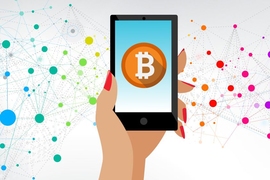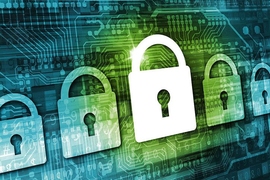In 1868, the fledgling Massachusetts Institute of Technology on Boylston Street awarded its first diplomas to 14 graduates. Since then, it has issued paper credentials to more than 207,000 undergraduate and graduate students in much the same way.
But this summer, as part of a pilot program, a cohort of 111 graduates became the first to have the option to receive their diplomas on their smartphones via an app, in addition to the traditional format. The pilot resulted from a partnership between the MIT Registrar’s Office and Learning Machine, a Cambridge, Massachusetts-based software development company.
The app is called Blockcerts Wallet, and it enables students to quickly and easily get a verifiable, tamper-proof version of their diploma that they can share with employers, schools, family, and friends. To ensure the security of the diploma, the pilot utilizes the same blockchain technology that powers the digital currency Bitcoin. It also integrates with MIT’s identity provider, Touchstone. And while digital credentials aren’t new — some schools and businesses are already touting their use of them — the MIT pilot is groundbreaking because it gives students autonomy over their own records.
“From the beginning, one of our primary motivations has been to empower students to be the curators of their own credentials,” says Registrar and Senior Associate Dean Mary Callahan. “This pilot makes it possible for them to have ownership of their records and be able to share them in a secure way, with whomever they choose.”
The Institute is among the first universities to make the leap, says Chris Jagers, co-founder and CEO of Learning Machine.
“MIT has issued official records in a format that can exist even if the institution goes away, even if we go away as a vendor,” Jagers says. “People can own and use their official records, which is a fundamental shift.”
Ideas collide
When Callahan first read about the blockchain a few years ago, she was immediately intrigued. It seemed to provide permanence, convenience, and a level of security worthy of the student record, and she wondered: Could the Registrar’s Office use the technology to issue digital records, like a diploma? She decided to look into the possibility.
As it turned out, MIT’s experimentation with blockchain technology was already well underway. In 2015, Philipp Schmidt, the director of learning innovation at the MIT Media Lab, had begun issuing internal, non-academic digital certificates to his team. Schmidt had realized that, despite the rise of decentralized, informal online learning opportunities, there was no digital way to track and manage these accomplishments. He says he became interested in finding a “more modular credentialing environment, where you would get some kind of recognition for lots of things you did throughout your life.”
Soon, Learning Machine and Schmidt’s team at the Media Lab discovered they had a mutual interest in developing secure official records and began to collaborate. Throughout 2016, using Schmidt’s team’s prototypes, they developed an open-source toolkit called Blockcerts, which any developer or school can use to issue and verify blockchain-based educational credentials.
When Callahan and Jagers connected last fall, it became clear that a partnership on a small pilot would be an ideal way to put Blockcerts to the test. “Mary was very up-to-date and had been introduced to concepts of cryptography, so she and her office were really excited to try out this technology,” says Jagers.
Callahan says that, for the Registrar's Office, “it was the perfect confluence: technology developed at MIT and a vendor who was aware of MIT’s culture as a community that values learning, at a time when a comprehensive record of lifelong learning was an evolving need.”
Harnessing the power of the blockchain
That technology draws on the Bitcoin blockchain, an open, global ledger that records transactions on a distributed database. Each transaction — known as a block — is encrypted, timestamped, and then added to the previous block on the chain, creating a timeline. A transaction cannot be modified once it is recorded, because any change in one block would require the alteration of all subsequent blocks, and because the information is distributed across a decentralized, worldwide network of computers.
The software Learning Machine developed uses the Bitcoin blockchain, but it’s not the only blockchain around. Jagers says that recently there has been a proliferation of new types of blockchains, but that Bitcoin remains the gold standard for Learning Machine’s purposes because it prioritizes security over other qualities like speed, cost, or ease of use. “We believe it’s still the right choice for official records that need to last a lifetime and work anywhere in the world,” he says.
Learning Machine also recognized early on that there was a missing link in the system, despite the potential of blockchain technology to make official, recipient-owned credentials a reality. In order for the information to be encrypted, the user also needs to obtain a public and private key — a set of unique numerical identifiers that represent them.
“It’s a huge roadblock to tell students to go generate public-private key pairs for the Bitcoin blockchain,” Jagers says. “Nobody has any idea what you’re talking about.”
Blockcerts Wallet solves that problem. After the student downloads the app, it generates the public-private key pair and sends the public key to MIT, where it is written into the digital record. Next, a one-way hash (a string of numbers that can be used for verification later) is added to the blockchain. The diploma information itself doesn’t go onto the blockchain, just the timestamped transaction indicating that MIT created the digital record. Finally, MIT emails the digital diploma (a JavaScript Object Notation file, or JSON) with the student’s public key inscribed into it. Because the mobile app on the student’s phone has their unique private key, the student can prove ownership of the diploma.
The pilot begins
This year, the Registrar’s Office contacted 85 master of finance and 26 master of science in media arts and sciences June graduates to let them know their secure digital diplomas were available via the Blockcerts Wallet app.
For students, the benefits go beyond mere novelty. They can share their diplomas almost immediately with whomever they please, free of charge, without involving an intermediary. This is particularly important for students who need to prove to an employer or another university that they have an MIT diploma. And thanks to the blockchain, the third party can easily verify that the diploma is legitimate without having to contact the Registrar’s Office. Using a portal, employers or schools can paste a link or upload a student’s digital diploma file and receive a verification immediately. The portal essentially uses the blockchain as a notary, locating the transaction ID (which identifies when the digital record was added to the blockchain), verifying the keys, and confirming that nothing has been altered since the record was added.
Callahan is pleased with the outcome of the pilot so far.
“Our goals were to build our own knowledge and confidence, while utilizing student feedback,” she says. “We believe this adds great value to higher education.” In fact, Callahan has already received inquiries about the pilot from a number of universities around the world and from colleagues in the European Commission.
The promise of transformative technology
Both Callahan and Jagers agree that the blockchain technology has enormous potential.
“We’ve just begun to scratch the surface of where this will lead. It’s really an exciting time,” Callahan says.
One possible application is creating stackable certificates on the blockchain, which would enable an individual to link credentials from different institutions — for example, an undergraduate degree from one university, a graduate degree from another, and a professional certification. Jagers says he believes it will soon be possible to embed links or IDs of other pre-existing digital records into a new meta-record.
“It’s not just about solving a problem,” he adds. “It really is transformative. And it could be as big as the web, because it affects every sector. It’s not just academic records. It’s being able to passively know that digital things are true. That creates a whole new reality across every sector.”
The Registrar’s Office has expanded the digital diploma pilot to include a cohort of students who graduated in September. Over the long term, Callahan hopes to explore the possibility of offering digital records for other learning credentials MIT students may obtain from programs such as MIT Professional Education, the Kaufman Teaching Certificate Program, and the Bernard M. Gordon-MIT Engineering Leadership Program.
Vice Chancellor Ian Waitz calls the new ability for MIT to issue robust and portable credentials “exciting, and necessary, to keep up with the demands of our on-campus students and learners around the world.”
“It’s also gratifying to see how innovation happens everywhere here, especially in places where you might not expect it like our Registrar’s Office,” Waitz says. “I applaud their creative experimentation and see their approach as a model and source of inspiration for others to push academic boundaries.”
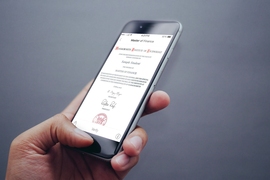
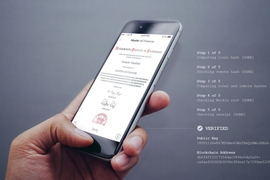
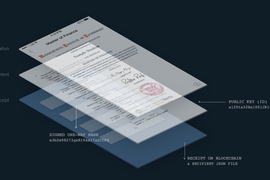
![The MIT digital diploma “makes it possible for [students] to have ownership of their records and be able to share them in a secure way, with whomever they choose,” says Mary Callahan, MIT registrar and senior associate dean.](/sites/default/files/styles/news_article__download/public/download/201710/MIT-blockchain-encrypted-digital-diploma-00.png?itok=aq3Rn8BG)


![The MIT digital diploma “makes it possible for [students] to have ownership of their records and be able to share them in a secure way, with whomever they choose,” says Mary Callahan, MIT registrar and senior associate dean.](/sites/default/files/styles/news_article__image_gallery/public/images/201710/MIT-blockchain-encrypted-digital-diploma.png?itok=-EpS2AuU)
